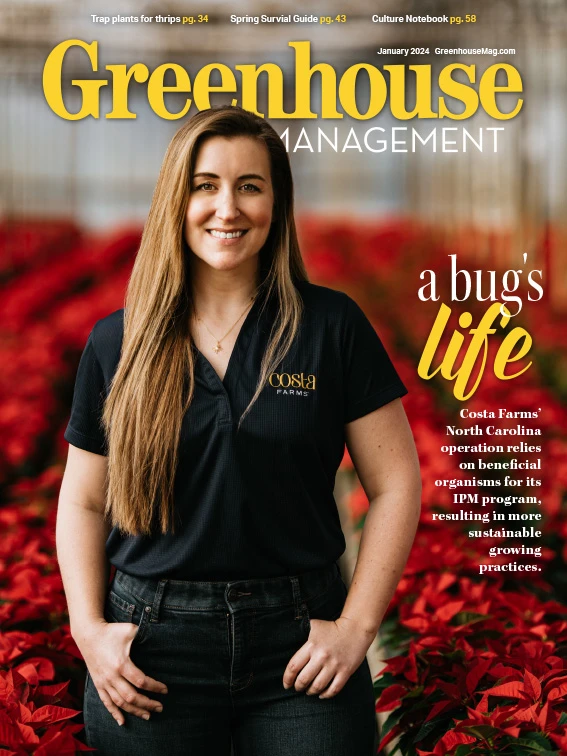
As head grower at Ebert’s Greenhouse Village in Ixonia, Wisconsin, Jason Wenninger works hard to uphold the legacy of his mentor, the late Ron Ebert.
“He took me under his wing and got me into growing,” says Wenninger, who started working at Ebert’s in 1998 right out of high school and became Ron’s assistant grower a few years later. “I learned the ins and outs of growing, working with Ron Ebert, and from that instant, it was my passion.”
After several years under Ron’s wing, Wenninger decided to explore other aspects of the green industry, and he left Ebert’s in 2009 to work for BFG Supply Co. — first in the warehouse, then inside sales, then as an outside sales representative. This role exposed him to growing supplies, products, tools, equipment and plant material “that took my knowledge of plants to a whole different level,” he says.
In August 2015, Ron Ebert died suddenly at age 57. His younger brother, Mark Ebert, who now runs the business that their father started in 1976, asked Wenninger to return to Ebert’s in 2016 to fill Ron’s place as head grower.

Growing more efficiently
Ebert’s Greenhouse Village spans about 300,000 square feet under cover where Wenninger and his team grow a variety of annuals, perennials, herbs, and vegetables. Although some of the production space is closed to the public, the majority of the greenhouses are open to retail customers.
“A hundred percent of what we grow here, we sell retail,” Wenninger says. “The only things we buy in that we do not grow are tropicals from Florida and all of our trees and shrubs. But all of our perennials, we start as either bareroot or plug, and we grow from there. All of our annuals, herbs and vegetables, we grow ourselves.”
Wenninger relies on his assistant grower and another grower to handle most of the day-to-day tasks like watering and applying inputs. He estimates that 80% of the plants in Ebert’s greenhouses are hand-watered — everything except the hanging baskets, which use automated drip irrigation. It may take two growers 24 hours to water three main crops in Ebert’s large 30,000-square-foot greenhouse, which holds 12,000 New Guinea impatiens, 10,000 begonias and at least 8,000 coleus.
To ease these labor demands on his small team, Wenninger is always looking for ways to grow more efficiently. For example, he’s exploring capillary mats to wick moisture into pots with less manpower. “If those three main crops were on capillary mats, that would take off 24 hours of watering,” he says. “That’s a game changer.”
Other updates throughout the operation have helped make growing easier. For example, Ebert’s built a new 14-foot gutter-connect Nexus greenhouse in 2019 to replace several older Quonsets, adding numerous efficiencies. In 2020, they replaced 12 old basket fans with three more efficient shrouded fans, making a big difference in energy consumption and temperature consistency. “Heat and humidity are better distributed with those shrouded fans, and we’re actually saving electricity,” Wenninger says.

Trialing new solutions
Wenninger frequently trials new plants, products, and techniques in the greenhouse — not only to help Ebert’s expand its inventory, but also to help the entire profession benefit from new introductions.
“I love trialing products,” he says, “because it’s helping other growers, and hopefully down the line, it’ll help the whole industry.”
For example, his good rapport at BFG opens the door to new products before they hit the market. Ebert’s also partners with Plantpeddler, Ball Seed Co., and other suppliers to trial new plant varieties every year.
Through recent trials of Verano365’s new nutrient adjuvant, Evofactor, and Bio-SuperSil, a soluble silicon fertilizer from Faust Bio-Agricultural Services, Wenninger discovered how to reduce the amount of fertilizer needed to maintain the same crop quality. “Rather than growing mums at 300 parts per million, which is normal for growing mums, we’re one of the few greenhouses that are growing mums at 75 parts per million, and they look beautiful,” he says. “With fertilizer prices going where they are, other greenhouses are trying to cut fertilizers or cut crops, but we’re actually making more crops and using less, while getting the same results, if not better.”

Continuing the legacy
Throughout his 25-year-career, Wenninger has gained a great appreciation for the art and science involved behind-the-scenes in growing. “People don’t see what happens in the background, but as a grower, you’re pretty much the unsung hero,” he says. “Starting a plant in plug or cutting stage and seeing it grow into a finished product, that’s a huge reward to any grower.”
After learning the ropes from one of the industry’s greats, Wenninger is committed to passing on the torch and sparking the same passion for plants in the next generation of growers.
“Have confidence in the new generation, and don’t discredit them,” he says. “Nurture and nourish their hunger, and help it grow — but don’t forget about the people who got you where you are. We’ve got to remember our roots, no matter how busy we get.”

Explore the January 2024 Issue
Check out more from this issue and find your next story to read.
Latest from Greenhouse Management
- Pennsylvania Horticultural Society shares top gardening trends from 2025 Philadelphia Flower Show
- California Spring Trials 2026 dates announced
- Les Evans promoted to DRAMMwater segment manager, Al Zylstra to retire
- Hoffmann Family of Companies to acquire N.G. Heimos Greenhouses
- GIE Media Horticulture Group wins five regional 2025 Azbee Awards of Excellence
- Grant awarded to test western U.S. wood species for use as wood fiber potting substrate
- Pennsylvania Horticultural Society announces 2025 Gold Medal Plant winners
- Oasis Grower Solutions announces new Southeast territory sales manager





